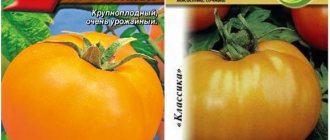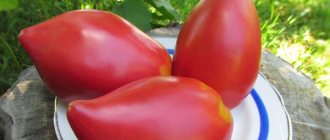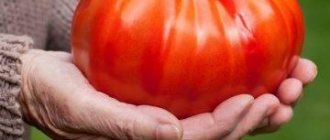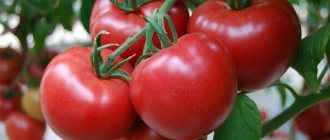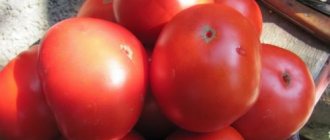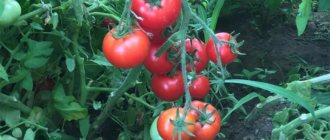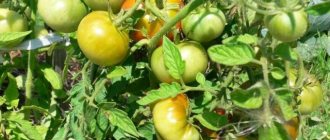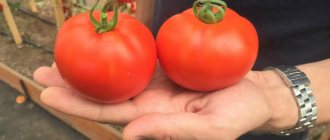Description of the variety
"Yellow Banana" is an indeterminate plant with a strong stem and plenty of foliage. The bush grows up to 3 m in height.
In terms of the degree of ripening, “Yellow Banana” is a medium-late variety. It takes 125 days from planting seeds for seedlings to harvesting.
The bush has medium-sized light green leaves with an openwork shape. A simple intermediate inflorescence is formed every 2 leaves.
The fruits are located in clusters. One brush contains a large number of tomatoes - about 10 pieces. When ovaries form, the plant must be pinched at the growing point so that nutrients enter the ripening tomatoes.
HELP: The plant is not standard.
Main characteristics of the fruit:
- Oblong shape;
- Length about 7 cm;
- Average weight is 120 grams;
- Yellow;
- Fleshy pulp;
- Smooth and durable skin;
- Two seed chambers;
- Some seeds;
- Average dry matter content.
Characteristics
- In terms of ripening time, orange banana is a mid-ripening species. The period from the appearance of full shoots to the beginning of ripening lasts 105 -110 days;
- The yield is good - 3 - 3.5 kg of ripe fruits are harvested from one bush. According to the State Register, the marketable yield is 8.3 - 9.2 kg per 1 square meter. According to gardeners, one bush can produce up to 40 bright tomatoes;
- Tomato immunity is very good, there is high resistance to fusarium and cladosporiosis, which can cause trouble for the red-fruited Banana;
- The plant is not resistant to cold weather, so for the first time after transplantation, the film covers should not be completely removed;
- the skin is not strong enough to protect the fruit from cracking;
- The harvest of this variety tolerates transportation well, but for this it is still advisable to harvest the fruits at the stage of technical ripeness. The shelf life is excellent, according to some reports it is about 2 months if storage standards are observed;
- The method of consuming fruits is universal. Gardeners unanimously agree with this statement. Tomatoes are great for salads, whole-fruit canning (they are very good in jars, especially with other colorful tomatoes), and processing into tomato products.
Tomatoes: advantages and disadvantages
The review variety has a large number of positive features:
- Unusual shape and color;
- High yield;
- The fruits do not crack;
- Dense, juicy, aromatic pulp;
- Excellent taste;
- Dense thin skin;
No negative characteristics were found in Yellow Banana tomatoes.
- Long shelf life of fresh tomatoes;
- The fruits do not cause allergic reactions in humans;
- Tomatoes can be used to prepare baby food;
- Tomatoes contain a large amount of vitamins and amino acids.
Agricultural technology
It is recommended to grow tomatoes through seedlings. Seeds are sown from the end of February to the third ten days of March, depending on the region. Seedlings aged 60-65 days with 5-7 true leaves are suitable for transplanting into the ground. If at the time of transplanting into the ground the threat of return frosts has not yet passed, then the plants are covered with a film cover.
Choose a place with maximum light - sunlight promotes the accumulation of sugars. The recommended density is up to 4 pieces per 1 square meter. The bush requires gartering and moderate pinching. Usually it is customary to pinch the plant over 3-4 flowers. To increase productivity, the bush is formed into 2 - 3 stems. Some gardeners grow the plant with 3 - 4 stems.
Maintenance is quite simple. The variety needs moderate watering, but sufficient to maintain the soil in a moderately moist state. Fertilizing is mandatory - nitrogen is required during the growth period, and phosphorus-potassium fertilizers are required during crop formation. Loosening after watering breaks up the formed earthen crust and helps to establish air exchange in the roots.
The red banana is valued for its high yield; housewives can use the harvest for processing and whole-fruit canning, which is a great way to diversify the table in the winter. Unpretentious in care, the culture works equally well for both professionals and beginners. Of course, there are also dissatisfied people who complain about the low harvest.
It is also recommended to grow this variety through seedlings. In order for the crop to show maximum potential, it is recommended to form it into 1 - 2 stems with mandatory pinching. Otherwise, the agricultural technology is very similar to that already described above. The only differences are in the frequency of watering. Here you should take into account the fact that under a film cover the soil remains moist longer than in an open bed.
Planting seeds for seedlings is carried out taking into account climatic conditions. The seedlings are transplanted to a permanent place after 2 months, when the plant has 7 - 8 true leaves. Planting pattern: 40 cm between bushes, 60 cm row spacing. The bush must be tied up and stepsoned. It is recommended to grow in 2 stems. Otherwise, caring for the variety corresponds to what is generally accepted for the culture as a whole.
Yellow banana is a very young variety, but already quite famous among tomato growers. This was facilitated by good yield, good immunity, unpretentiousness, and most importantly, the bright appearance and excellent taste of tomatoes. Nothing is known about the shortcomings yet.
In conclusion, I would like to remind you that every tomato grower can collect seeds from the variety he likes on his own. The grown crop will fully comply with the declared characteristics. There are many reviews about the multi-colored varieties of Banana, most of them are positive; many tomato growers have been growing the crop for more than one year and are not going to give it up.
It is recommended to grow tomatoes through seedlings. Seeds are sown from the end of February to the third ten days of March, depending on the region. Seedlings aged 60-65 days with 5-7 true leaves are suitable for transplanting into the ground. If at the time of transplanting into the ground the threat of return frosts has not yet passed, then the plants are covered with a film cover.
Choose a place with maximum light - sunlight promotes the accumulation of sugars. The recommended density is up to 4 pieces per 1 square meter. The bush requires gartering and moderate pinching. Usually it is customary to pinch the plant over 3-4 flowers. To increase productivity, the bush is formed into 2 - 3 stems. Some gardeners grow the plant with 3 - 4 stems.
We invite you to familiarize yourself with Tomato Jalpa: description and characteristics of the variety, reviews of tomato yields, photos of the bush || Jalpa tomato
Maintenance is quite simple. The variety needs moderate watering, but sufficient to maintain the soil in a moderately moist state. Fertilizing is mandatory - nitrogen is required during the growth period, and phosphorus-potassium fertilizers are required during crop formation. Loosening after watering breaks up the formed earthen crust and helps to establish air exchange in the roots.
The red banana is valued for its high yield; housewives can use the harvest for processing and whole-fruit canning, which is a great way to diversify the table in the winter. Unpretentious in care, the culture works equally well for both professionals and beginners. Of course, there are also dissatisfied people who complain about the low harvest.
It is also recommended to grow this variety through seedlings. In order for the crop to show maximum potential, it is recommended to form it into 1 - 2 stems with mandatory pinching. Otherwise, the agricultural technology is very similar to that already described above. The only differences are in the frequency of watering. Here you should take into account the fact that under a film cover the soil remains moist longer than in an open bed.
Planting seeds for seedlings is carried out taking into account climatic conditions. The seedlings are transplanted to a permanent place after 2 months, when the plant has 7 - 8 true leaves. Planting pattern: 40 cm between bushes, 60 cm row spacing. The bush must be tied up and stepsoned. It is recommended to grow in 2 stems. Otherwise, caring for the variety corresponds to what is generally accepted for the culture as a whole.
Yellow banana is a very young variety, but already quite famous among tomato growers. This was facilitated by good yield, good immunity, unpretentiousness, and most importantly, the bright appearance and excellent taste of tomatoes. Nothing is known about the shortcomings yet.
In conclusion, I would like to remind you that every tomato grower can collect seeds from the variety he likes on his own. The grown crop will fully comply with the declared characteristics. There are many reviews about the multi-colored varieties of Banana, most of them are positive; many tomato growers have been growing the crop for more than one year and are not going to give it up.
Growing tomatoes
Like many other tomatoes, the Yellow Banana variety is grown in seedlings.
How to prepare seeds?
Planting material is planted for seedlings at the end of February. Seeds require specially prepared soil
IMPORTANT: It is recommended to disinfect and steam the soil before planting seeds. To disinfect soil, a weak solution of manganese is often used. The seed material is treated with special preparations.
Sowing seed material
Seeds are planted in containers or small boxes to a depth of about 2 cm. The distance between plantings should be at least 2 cm.
The soil is sprayed with warm water, the containers are covered with plastic wrap. After the sprouts appear, the film is removed and the seedlings are placed in a well-lit place.
The optimal temperature for seedling growth is at least 25 °C.
Picking is carried out after two true leaves appear on the plants.
Rules for planting seedlings
The seedlings are transferred to the greenhouse at the end of April or beginning of May. The soil in the beds should be fertilized with humus and loosened well.
The seedlings are placed in the holes. The distance between seedlings should be about 40-50 cm. For good growth, tomatoes need a well-lit place.
Banana Yellow and Raspberry Dawn:
Banana red
An application for registration of this variety was submitted in 1996 by Agrofirm Gavrish and K LLC and Selectionnaya LLC.
The new product was included in the State Register of Selection Achievements in 1997 with admission to all regions of the country. Recommended for cultivation in open ground and in temporary film shelters in garden plots, homesteads and small farms. This tomato is not a hybrid. An application for registration of this variety was submitted in 1996 by Agrofirm Gavrish and K LLC and Selectionnaya LLC. The new product was included in the State Register of Selection Achievements in 1997 with admission to all regions of the country. Recommended for cultivation in open ground and in temporary film shelters in garden plots, homesteads and small farms. This tomato is not a hybrid.
The plant is determinate, creeping, about 70 - 100 cm high. The branching is strong, the foliage is moderate. The leaves are of regular shape, medium in size, slightly corrugated, light green, with no stipule. Yellow flowers form 2 types of inflorescences - simple and intermediate. The first fruit cluster appears above the 8th - 9th leaf, the subsequent ones are laid after 1 - 2 leaves. Each brush has from 8 to 12 ovaries. Pedicel with articulation.
The tomato has a rather presentable appearance. The shape resembles a typical “cream” - the Red Banana fruit is cylindrical, smooth, and moderately elastic. An unripe tomato of this variety is light green. At the stage of consumer ripeness it turns a uniform red color. The skin is of medium density, according to reviews, sometimes even harsh, durable, glossy.
The pulp is moderately juicy, fleshy, contains a large percentage of dry matter, without voids and a white core (only a few reviews indicated a slight white spot, and then near the stalk itself), and has few seeds. The number of seed chambers is 2 - 3. The State Register notes the taste qualities of fresh fruits as good and excellent.
The Banana variety of tomato appeared quite recently. It was bred specifically for the climatic conditions of Russia. This variety has several subspecies that differ in color: Banana tomato is red, pinkish, yellow, orange, spotted. The vegetable received this name for the unusual shape and arrangement of tomatoes on the branch. They are similar to tropical fruits.
Their peculiarity is that they have strong immunity to many diseases, several fruits ripen on a branch at once, and are shaped like bananas. The characteristics and description of the variety make it possible to explain to gardeners how this crop differs and how to properly care for it.
The description of the Red Banana tomato variety can be read on the packet of seeds. This crop is a selection variety that ripens quite early, practically does not get sick and bears several ripe fruits on one bush. This variety is not multi-yielding, therefore, if you need to get high yields, you can plant many bushes at once, or choose a different variety. The bushes are not very tall, so they do not need a garter.
Tomatoes are elongated and small in size, similar to bananas. One fruit weighs no more than 80 grams. The skin is dense, the flesh is sweet. They tolerate transportation well over long distances. Tomatoes can be cut into salads, soups, and salted in jars. They are a bit dry for juices. In addition to red tomatoes, there are also varieties of tomato: Pink Banana and Variegated Banana. They are relatives of the banana family, differing only in color.
The variegated variety has tall bushes and very unusual fruits: striped red-yellow, curved downwards, sweet and tasty. They are used mainly for making adjika, tomato paste.
There is also a Golden Banana tomato. They have yellow fruits that hang on the bushes like banana bunches, fleshy and juicy. If anyone is allergic to red vegetables, then this type is ideal to eat.
Reviews about these varieties are very positive. Although, like everyone else, they have their drawbacks. They can become infected with fungal diseases. It is transmitted mainly from the soil or from other plants. Therefore, for prevention, it is better to periodically spray with special means.
All lovers of exclusive species need to know how to grow them correctly. Good care is required to achieve the desired harvest.
If you look at the description of the variety, you can see that these tomatoes ripen early, which means that the seeds germinate quite quickly. They require a lot of nutrition and strength to grow, warmth and good watering.
Since the variety is very sensitive to fungal diseases, prevention against them must begin from the seeds. They are soaked in a solution before planting, which will help develop immunity in the future. Later, the bushes in the greenhouse are periodically treated to prevent fungus or insect attacks.
The secret to growing from seed is simple: you need to plant it not very deep in a container at the same distance and wait for germination. While the shoots are growing stronger, they need to be provided with comfortable conditions.
- The box with seedlings is placed on the sunny side of the window (you can put an additional lamp);
- Water every time the soil dries out;
- Take it outside for a while, ventilate and harden it.
When the seedlings grow and become stronger, they are planted in a greenhouse. This usually happens after two months. The soil in the greenhouse must be well fertilized and watered. Tomatoes in a greenhouse should not be forgotten to be watered once a week and ventilated by opening doors and windows. Watering is carried out in the evening. It is worth remembering that if you water too much, fungus may develop. Therefore, this should be done only when the ground is dry.
Periodically, the soil is loosened and weeded, removing weeds that take away nutrients from the vegetable. This must be done carefully, without damaging the stems and roots.
We invite you to familiarize yourself with what a Finnish house means
New seeds are bought every year. When tomatoes are grown, they will not sprout or produce the desired variety.
With proper care, one bush can produce up to 10 vegetables that resemble small bananas, which will delight the family with their taste and unusual shape.
Lyudmila, 45 years old: I decided that this year I will plant Red Banana tomatoes. I bought the seeds in a special store. I'm very pleased. The long fruits ripen almost simultaneously, they do not require supernatural care, they are very tasty and aromatic. I salted the smaller ones a little into the jars. They also go well for preservation. Crispy, with thick skin. Next time I will try the Banana yellow tomato variety.
Red Banana and other tomatoes are suitable for those gardeners who dream of growing unusual varieties in their dacha. Knowing and fulfilling all the requirements for their cultivation, you can get an excellent harvest in the form of beautiful and tasty fruits. Those who planted them once want to grow them again and again.
The red banana is not an exotic fruit at all, but a new, very good variety of tomato. In just a few years, many gardeners in Russia and neighboring countries managed to appreciate it. The unique name of the variety corresponds to the original shape and color of the tomatoes. “Red Banana” is loved by farmers due to its unpretentiousness, high yield, and good quality of fruits.
The “Red Banana” variety is the result of the work of domestic breeders. Its main advantage lies in the early ripeness of vegetables and the high resistance of the crop to unfavorable external conditions. The combination of these characteristics makes it possible to grow tomatoes even in the most difficult climatic regions.
Banana orange
The orange-fruited namesake appeared in 2005. Its applicants were 3, Agro LLC. Since 2006, the variety has been in the State Register of Breeding Achievements of the Russian Federation with admission to 7 regions - Northwestern, Northern, Central, Central Black Earth, Volga-Vyatka, North Caucasus and Middle Volga. Recommended for growing under film covers in private farms. Not a hybrid.
The plant is indeterminate, about 1.5 meters or higher in height. The stem of the variety is not too thick. Tomato foliage is moderate. The leaves are medium-sized, long-petiolate, regular in shape, green. Inflorescence of simple form. Fruit clusters are laid through 3 leaves. 5 - 6 clusters are formed on the main stem. There are up to 7 ovaries on one hand.
The fruits of the Orange Banana are elongated, cylindrical, smooth, and moderately elastic. An unripe tomato is light green; a ripened one turns a smooth, bright orange color. Thanks to this, the bush, decorated with ripe tassels, looks decorative. The pulp is very fleshy, with a high content of lycopene, tender, moderately dense, juicy, contains few seeds, and aromatic.
The seed nests are small, numbering from 2 to 3. The tomato skin is thin and shiny. The taste of fresh fruits of this variety is excellent, you can feel the sweetness, and the sourness can slightly remind you of itself in slightly unripe tomatoes. According to the State Register, orange-fruited tomatoes are slightly larger than red-fruited ones - weighing from 85 to 92 grams.
We suggest you read How to store garden tools
The orange-fruited namesake appeared in 2005. Its applicants were 3, Agro LLC. Since 2006, the variety has been in the State Register of Breeding Achievements of the Russian Federation with admission to 7 regions - Northwestern, Northern, Central, Central Black Earth, Volga-Vyatka, North Caucasus and Middle Volga. Recommended for growing under film covers in private farms. Not a hybrid.

